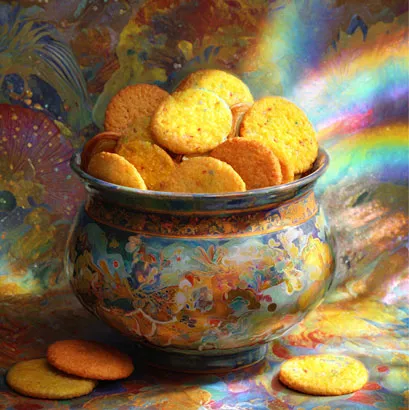Váirú Senshai - Rainbow's Blessing
It is said that at the end of the rainbow, happiness or a pot of gold awaits, at least if you believe earthly folk myths. Keep believing, even if the pot of gold has been misinterpreted and falsely blamed on goblins. The true origin lies hidden among the clouds, the rays of the sun, and the rainbows in the realm of the fairy elves of Téshàn and is already several thousand years old.
Once upon a time, at the edge of the Téshànian jungle, there lived an old fairy elf who ventured into the depths of the forest every day to tap the white sap from barkmilk trees. At home, he placed the pot of liquid in the open window and added honey, a few spices, chopped color nuts, and some star grain to allow it to swell in the creamy milk. But in all his work, the fairy elf forgot about the pot and went back into the forest the next day. When he returned, his house was bathed in the colorful rays of a rainbow, and small, sparkling golden stars rose from the window. Then he remembered the pot and ran into the house. But what he found wasn't the sweet porridge he had expected; instead, glittering in the rainbow light were golden, round coins that smelled wonderfully of spices. He timidly took one of the coins in his hand, inhaled the sweet aroma of the biscuit, and nibbled on it. With the first bite, he was overcome by a wonderful feeling of happiness, as if the rainbow had showered blessings over the dough and baked them into the golden delicacy. The fairy elf grabbed the pot and excitedly ran to his neighbor and her family. Each of them tasted the thaler and was also filled with the same blessing of good luck. Of course, it wasn't long before the whole village knew about the delicious pastries and the miracle of the rainbow. This led to everyone soon trying to receive their own rainbow blessing. Whether they actually succeeded is unknown, but the village grew into a town that grew rich by baking golden-yellow cookies and incorporated the thaler under a rainbow into its town coat of arms. Perhaps this was the true blessing of the rainbow?
Between Myth and Truth
"Váirú Senshai isn't available everywhere, you silly thing!. You have to order the pastries! And your chances of receiving truly blessed cookies are best during the Lupésian rainbow season in spring or fall. Everything else is just plain cookies!" - Warning to a tourist in Tégashai -
Well, there are several cities in southern Téshàn today that bear a rainbow and biscuit thaler in their coat of arms. The oldest of these is Tégashai. Whether the other cities were inspired by the myth as their own or whether they also received the blessing cannot be truly confirmed. The first recorded account of the miracle dates back to the 3rd millennium BCE in the "Chronicle of the Myths of the Wind," written by Yama Giranda. But of course, most cities claim to have been the true city of the first rainbow blessing, even if they were founded after the chronicle was written.
All of the stories are connected by the rainbow, whose radiance transformed dough into pastries, bringing prosperity and growth to the cities. What changes are the location, the fairy elves who received the blessing, and the ingredients. For this reason, there are various recipes, all of which claim to be authentic Váirú Senshai. Even if they may not be the cookies made according to the original recipe, you can be sure that all of them, thanks to their deliciousness, hold a little bit of luck and blessing for you.
Recipe for 20 cookies
"Unfortunately, we can only share the recipe for cookies with the Váirú Senshai ingredients, and you'll have to bake it yourself, as we can't predict when the best rainbow season is for you. Thank you for your understanding."- Váirú Senshai-Baker from Téshàn -
Mix the butter, honey, and barkmilk until creamy. Mix the stargrain flour, ground and chopped daydream and colored nuts, and spices together. Fold in the milk cream and knead well. Let the dough rest in a cool place for one hour.
Shape the dough into a long log, cut into 20 equal pieces, and bake at about 180°C for about ten minutes. The cookies are done when they are golden brown.
Ingredients
400 rés barkmilk
150 rés stargrain flour
150 rés butter
75 rés daydream nuts, ground
75 rés colored nuts, chopped
1 sásh póxé, streaked glimmervanilla
3 sásh úqé honey
1 thípha salt
Zest 2 candytangelos
1 sásh póxé tigergalangal, freshly grated Difficulty: easy
Preparation time: 30 min preparation
1 hour rest - 10 min baking Quantities:
rês - Grains (g)
thípha - Quill pen tip (msp/pinch)
sásh póxé - Small spoonful (tsp)
sásh úqé - Large spoonful (tbsp)
150 rés stargrain flour
150 rés butter
75 rés daydream nuts, ground
75 rés colored nuts, chopped
1 sásh póxé, streaked glimmervanilla
3 sásh úqé honey
1 thípha salt
Zest 2 candytangelos
1 sásh póxé tigergalangal, freshly grated Difficulty: easy
Preparation time: 30 min preparation
1 hour rest - 10 min baking Quantities:
rês - Grains (g)
thípha - Quill pen tip (msp/pinch)
sásh póxé - Small spoonful (tsp)
sásh úqé - Large spoonful (tbsp)









Ok jetzt wird das mit dem Schwarmbewusstsein unheimlich: Kekse! Ok bei mir ist es ein anderer Prompt, aber trotzdem!
Aber sehr tolle Idee das die Legende nicht nur viele Rezepte sondern auch Stadtwappen inspiriert hat!
Besonders gefallen mir Anmerkungen aus Tourismus und dem Fachwerk! - Damit rechnet man nicht bei einer schönen kleinen Geschichte!
A lot of unofficial Challenges
Danke, dass es Dir gefällt, dass mit dem Stadtwappen ist einfach so beim Schreiben passiert ;).
Here are my Entries for the water continent Ulűri̋qi̋